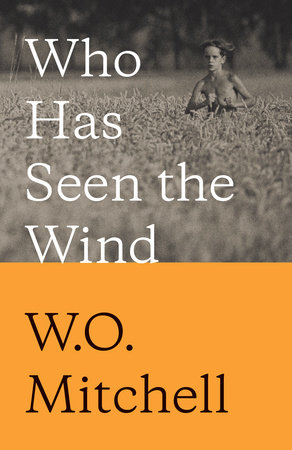
I’ll soon be setting out on a road trip that takes me through the Prairies. I prepare for trips like this, not by planning where to stay or by careful packing that anticipates every possible weather situation, but by reading books from the places I expect to visit. I’m mostly interested in packing my mental suitcase. First on my packing list is W. O. Mitchell‘s Who Has Seen The Wind. Although the book has sold a gazillion copies and has been read by half of all Canadian school children, I somehow escaped its clutches. Even after I had graduated from school and had bought a copy because I thought it would be good for me, the book sat unread on my shelf. The reason for my reader’s block has something to do with the blurb on the back cover, which I’ve reproduced here, indicating the icky parts with underlines and boldface:
W.O. Mitchell’s best-loved book tells a timeless and heartwarming tale of the young boy, Brian O’Connal, who grows up with the restless wind, the endless sweep of sky, the lonesome prairie of Saskatchewan. The sunlit story of a boy and his dog, his first skates, his gang, and the shack where they sneak away for a smoke – it is also the deeply moving portrayal of a small Canadian town during the dark days of the Depression. Charged with a special people’s humour, courage, and strength of character, it stresses the qualities that protect a child’s innocence while giving him the burning need to know what makes a boy a man.
Gag.
Whether I like it or not, my reading sensibilities have changed since high school. I have become a postmodern – or even a post-postmodern – reader. I’m incapable of reading a novel that offers straight-up unaffected sentiment without hearing an ironic, snooty commentary running in the background. I imagine, hovering above the heads of the characters, cartoon thought-bubbles revealing what they might really say if only Mitchell would cut them some slack. “Can’t I get laid, just this once?” “Can’t I paint graffiti on the grain elevator, please, please, please?” “Can’t we march all the aliens down the main street in their underwear?”
By the way, there are no aliens in Who Has Seen The Wind. Instead, there is a heartwarming tale. As you’d expect from a heartwarming tale set in a Depression era Saskatchewanian town, the good people are pretty much good, and the bad people are pretty much annoying in the same way that Michele Bachmann is annoying. There is the obligatory OFFICIOUS CHURCH BUSY BODY who wreaks all kinds of harm in the name of doing good. And there is the MORALLY RIGID TEACHER who is so hell bent on following (and enforcing) rules that compassion shrivels up and dies on the classroom floor. And, of course, there is the wind of the title, the OVERARCHING METAPHOR which is closely identified with a mysterious boy and the land he inhabits, and the numinous spiritual quality that envelopes them both.
Mitchell’s writing belongs to a specific place. We see this in descriptions like the one I’ve reproduced here:
Spring came to the prairie with the suddenness of a meadow lark’s song. Overnight the sky traded its winter tang for softness; the snow, already honeycombed with the growing heat of a closer sun, melted—first from the steaming fallow fields, then from the stubble stretches, shrinking finally to uneven patches of white lingering in the barrow pits. Here and there meadow larks were suddenly upon straw stacks, telephone wires, fence posts, their song clear with ineffable exuberance that startled and deepened the prairie silence—each quick and impudent climax of notes leaving behind it a vaster, emptier prairie world. The sky was ideal blue. Crows called; farmers, impatient as though it were the only spring left in the world to them, burning with the hope that this one would not be another dry year, walked out to their implements, looked them over, and planned their seeding—barley here, oats there, wheat there, summer fallow there.
Literature of a place has to start somewhere. Maybe it is always the case that such literature starts with straight-up unaffected sentiment. It springs from a love of the place. Only later is it possible to approach the place with a critical eye, deploying less straight-up strategies like irony and parody. Only when the love is faded and the mystery demystified do the postmodern writers get their turn in that place to bang away at their keyboards.
I wonder if there is a critical equivalent of Elisabeth Kübler-Ross. Instead of delineating the stages of dying, it sets out the literary stages a culture engages as it colonizes a place. I suppose, in a way, colonization is a kind of dying. (The first stage is the fresh-faced author who writes the heartwarming tale. The second stage is denial; this place can’t be as imperfect as it seems. The third is bitter irony. Etc.) Now, in the twenty-first century, there are no more uncolonized places remaining on Earth where we can test such a theory of literary development. We’ll have to wait until we start colonizing the moon. Maybe the first lunar novel will be titled: Who Has Seen The Vacuum. It will be the heartwarming tale of a boy and his robot.